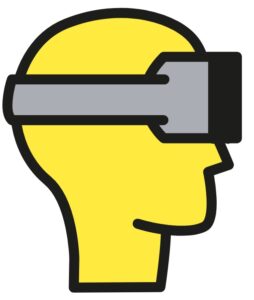
Self-driving vehicles are vehicles that do not require a human driver. Self-driving vehicles already exist. The technology is there and it works. Self-driving vehicles have been tested in real roads and they seem to be safer than human-driven vehicles (although machines also make mistakes).
But there is no road in the world used only by self-driving vehicles. This is a scenario that people can only imagine. How would people feel when the vehicle they are using does not have a human driver, and is interacting both with pedestrians and with other vehicles that also do not have human drivers? It’s difficult to test this scenario in real-life right now.
Virtual reality is a solution to understand more about this. Virtual reality can show scenarios with much detail, both of the interior of the vehicle, and of the outside. The scenarios can be integrated into head-mounted devices, i.e., “helmets” worn by participants in controlled experiments. Participants feel that they are immersed in a believable scenario that completely surrounds them.
The reactions of participants to what they experience can be measured using devices that monitor heart rate, skin reaction, or brain activity. A simpler method is just to ask participants what they felt, at the end of the experiment.
Virtual reality can be used to compare people’s experiences using human-driven vehicles and self-driving vehicles. It can also be used to compare different conditions for using a self-driving vehicle. Here are several of many possible examples: comparing busy vs. quiet roads, urban vs. rural environments, day vs. night, a few vs. many pedestrians and cyclists, fine vs. rainy weather, straight roads vs. road with many curves, vehicles moving vs. parking.
It’s also possible to test different designs for the interior and exterior of the vehicles and different driving styles.
Several academic studies have used virtual reality to understand how people would react to self-driving vehicles. Most of these studies are open access. To be honest, I found most of them difficult to read because of an unhealthy number of unnecessary acronyms. The studies also tend to rely on samples of only young people. In most cases, only students. And in some cases, mostly male students. Groups such as older people who cannot drive tend to be forgotten in this kind of studies. Maybe because students are easier to recruit for the experiments?
But the studies still have interesting information about the levels of trust that people place in self-driving cars, and the situations that cause anxiety. For example, several studies have found that people like to be informed by the vehicle of what is happening and what the vehicle is doing. Situations with pedestrians on the road tend to be seen with some anxiety.
This is an area with fast development so we will see more studies using virtual reality to study self-driving vehicles in the next few years. Hopefully they will be include more representative samples of the population that will use these vehicles in the future.